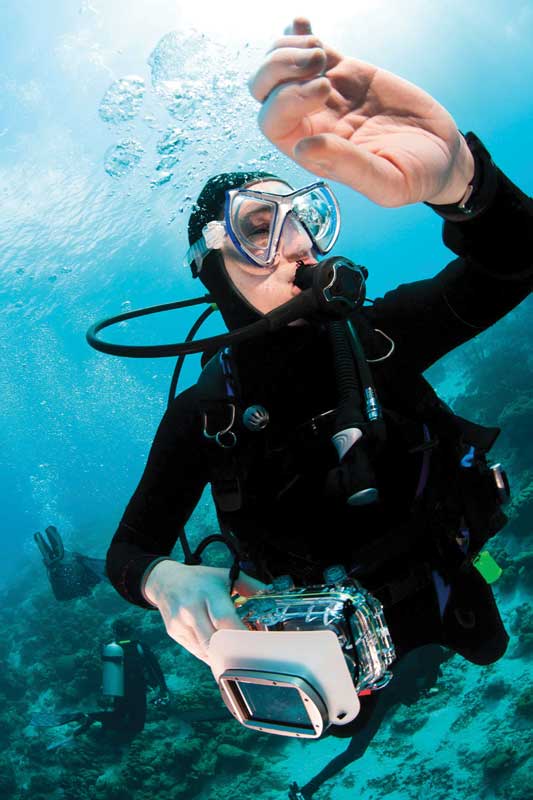Tiny Bubbles, Big Trouble
By Divers Alert Network

Decompression sickness (DCS) is a tricky condition. On one hand, we know a lot about who gets it and when—and even how to prevent it, but we do not have a definitive understanding of the mechanisms of bubble formation or injury. Decades worth of research have culminated in an understanding that divers bubble and get injured by some bubbles, and we have theories about how the number or size of bubbles affects risk of injury, but that’s as far as definitive mechanisms go. That’s not to say that we’re in the dark entirely; a combination of research, experience and conservative theoretical modeling have given divers tables that yield extremely low injury rates and the knowledge we require to keep ourselves safe. Understanding exactly what happens from bubble formation to the specific mechanism of injury and applying it to a useful calculation of DCS risk, however, is a tall order that hasn’t proved achievable—yet.
Virginie Papadopoulou, Ph.D., a researcher at the University of North Carolina, is working on an understanding of bubble mechanics that approaches the gaps in our knowledge both at a molecular level and a holistic one. Her work deals with the clinical applications of bubbles in ultrasound-targeted drug delivery, bubble formation in divers, and correlation of bubble counts with DCS risk. Work from her lab and others around the world with similar expertise have shown that the current post-dive bubble counts we see in divers do not directly correlate to DCS risk. Recent proposals from Papadopoulou and others have theorized that post-dive bubble counts may be able to correlate to DCS risk if more advanced ultrasound imaging is brought to bear. These researchers theorize that current bubble counts may not provide accurate data because they measure only bubbles of the size that can be accurately seen using traditional ultrasound technology, but more advanced methods may count significant quantities of extremely small bubbles that affect a diver’s risk.
(Really) Tiny Bubbles
The microbubbles Papadopoulou and others are trying to track down are almost incomprehensibly small and haven’t been on the radar of ultrasound imaging studies until now. Ranging from 1-10 micrometers in size, the smallest of these bubbles is about 1/100th the diameter of a human hair. Their ability to slip through our bloodstream without detection is the key to their potential effect on DCS risk.
Previous studies have shown that most divers produce some bubbles after a dive, but some produce significantly more than others, leading to the idea that some divers are “bubblers” and some are not. This discrepancy is at the core of the inconsistencies in DCS risk calculations; bubblers and non-bubblers can yield dramatically different bubble count data after identical dives even with external factors accounted for. Papadopoulou and her colleagues theorize that this may be because the non-bubblers are producing smaller bubbles but in similar quantities. More advanced imaging techniques are showing some promise in improving our ability to measure bubbles in both types of divers. This research is currently in progress, so we can’t yet change the way we dive because of it. However, it represents a significant change in the way DCS is understood and could be the next big step forward in preventing the condition.
Combining Models
In addition to looking at new ways to understand the quantity, type, and formation of bubbles in divers, researchers such as Papadopoulou are working to understand the individual mechanisms of DCS in combination with a holistic approach to the condition. Rather than just noting which divers had DCS and then modifying dive algorithms, these researchers are working to understand the effects of factors such as hydration, ascent rate, water temperature, exercise, body composition, and more—and then combining those with the quantitative data (bubble counts, for instance) they gather. Considering these risk factors in light of reported DCS symptoms as well as the broader picture of fatigue, aches, and other symptoms frequently dismissed as subclinical or caused by other factors related to diving may help us find new ways to understand the risks we face as divers and more accurately calculate our risk.
It’s impossible to tell if the current research is on the verge of illuminating the “black box” that is DCS risk or if we’re still decades away, but some impressive results have already come from this sort of research. As a community we can look forward to a field of young researchers interested in the clinical applications of bubble science as well as the improvement of our safety as divers. The end goal will be personalized decompression algorithms tailored to our individual physiologies and dive profiles, but how soon we’ll see these is hard to say. Even without definitive results, however, understanding the research process as it progresses may provide divers with new best practices to minimize their risks—even before all the secrets of DCS are discovered.
For more information on safe diving practices visit www.DAN.org
Leave a Comment







